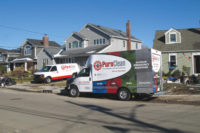Restoring Power to Post-Superstorm Sandy New Jersey
Sandy impacted two locations – Union Beach and Toms River – of a state power company, leaving between one and five feet of water throughout their two buildings






On October 29, 2012, Superstorm Sandy made landfall in New Jersey, bringing a devastating storm surge to the region. The downgraded hurricane left 72 dead in the mid-Atlantic and northeastern U.S., tens of thousands homeless, millions without power and billions of dollars in property damage. As the winds died down, residents and business owners began the long road to recovery. So did those whose expertise lies within restoration post-disaster. Enter PuroClean.
As the magnitude of the storm escalated, PuroClean activated its response protocol for such catastrophes – from organizing the franchise’s hundreds of technicians and locally-owned units to activating pre-event agreements with clients in the storm’s path. More than one-third of the nearly 300-unit system was mobilized to help those affected by Sandy, including some who drove from as far as South Texas and Georgia. Franchise owners George Cruz and Emilio Soli’s team – led by Bernie Tobin and Mike Crosby, project superintendents – were part of the massive clean-up efforts. They traveled from Brunswick, Ohio to help restore the Jersey Central Power & Light (JCP&L) and in turn, helped restore power to many New Jersey residents.
Sandy impacted two locations – Union Beach and Toms River – of this major state power company, leaving between one and five feet of water throughout their two buildings (located 45 miles apart), rendering them largely uninhabitable. Both buildings are mainly used as office, training, billing and warehouse space. The damage prevented JCP&L employees from assisting the millions of customers who had lost power.
PuroClean arrived on-site on the morning of November 1, 2012 to begin the restoration process. Like any large disaster, leads for projects came from a variety of sources – pre-arranged agreements, neighbors of customers, someone down the street who saw a truck/van, professionals “cold-calling,” franchise owners sharing projects, etc. This particular project was the result of a pre-disaster plan agreement between the Cleveland-area parent company of JCP&L (FirstEnergy) and the PuroClean franchise owner. Having a plan in place before disaster strikes leads to the most efficient recovery process.
When Tobin arrived at the site, he immediately conducted a thorough building assessment with the client, taking photos and measurements and using professional meters to determine the full extent of the damage. He then used that analysis to prepare a scope of work and recommendations. Once approved, PuroClean mobilized the necessary equipment, which arrived on November 3rd.
One of the many challenges Tobin and Crosby faced was the limited availability of large desiccant dehumidifiers and the lack of fuel needed for trucks to bring them to the site. Therefore they chose to use high-efficiency, low-grain refrigerant (LGRs) dehumidifiers together with air movers and Air Filtration Devices (AFD’s) – to help establish and maintain clean, safe air both for restoration workers and JCP&L employees. This approach also allowed the building to stabilize more quickly, since all of these were able to run off of the building power instead of waiting for outside equipment to arrive. Between the two locations of JCP&L, the team used roughly 200 pieces of equipment and 30-40 workers.
The next day, November 4, after Tobin had worked with an electrician to disconnect the many heating panels within the baseboards that had been submerged, the crews began the demolition phase. Beginning from the top down, they dropped the contaminated ceiling tiles. Next, crews pulled out the carpet. Then, after obtaining a “clean” asbestos evaluation of the structure, they began demolition of the walls and baseboards. Using power saws to make precise cuts, they took out the drywall and plaster.
Once all affected materials and debris had been removed, Tobin and Crosby led a detailed decontamination and sanitation process, taking the necessary steps to deal with the results of the Category 3 water intrusion, determined in accordance with the industry standard – the IICRC S500. This is based on the gross contamination present in all above ground flood waters. PuroClean removed all contaminants using industry standard procedures and professional products including EPA registered disinfectants.
Following the demolition and decontamination/sanitation, they proceeded to dry the structure.
“The appropriate use of dehumidifiers and high capacity air movers results in the most effective and efficient drying situation,” said Tobin. “AFD’s are essential to remove any possible contaminants from the air, ensuring the best possible indoor environment for our workers, as well as the employees of JCP&L.”
A clearance test, performed by an independent third-party, confirmed the success of the cleaning and drying operations. The facility was then ready for structural repairs and rebuilding to begin.
While damage costs neared $100,000, Tobin, Crosby and their teams were able to complete the PuroClean phases of the project in less than 10 days, despite the many challenges typically associated with a regional disaster like Sandy.
“In situations like this, you are always challenged with finding supplies, labor and other materials,” Tobin says. “Fortunately, we were able to bring a lot of what we needed on our capacity trailers and mobilized other dedicated equipment from our Atlanta operation. I can’t stress enough the importance of disaster preparedness. From a service professional’s perspective, having all resources lined up ahead of time really gives you a leg-up on the competition and the ability to coordinate with the client before you arrive on-site.”
Both Tobin and Crosby also emphasize the need for a timely response, especially when restoring a power provider like JCP&L.
Tobin said that the JCP&L facilities PuroClean helped restore were fully functioning within 45 days after Hurricane Sandy.
“Much of the rapid response and short recovery time is tied directly to pre-planning, especially the disaster preparedness plan and agreement,” says Tobin. “The repair contractor was able to come in after us and quickly rebuild because everything was set in place.”
Looking for a reprint of this article?
From high-res PDFs to custom plaques, order your copy today!







